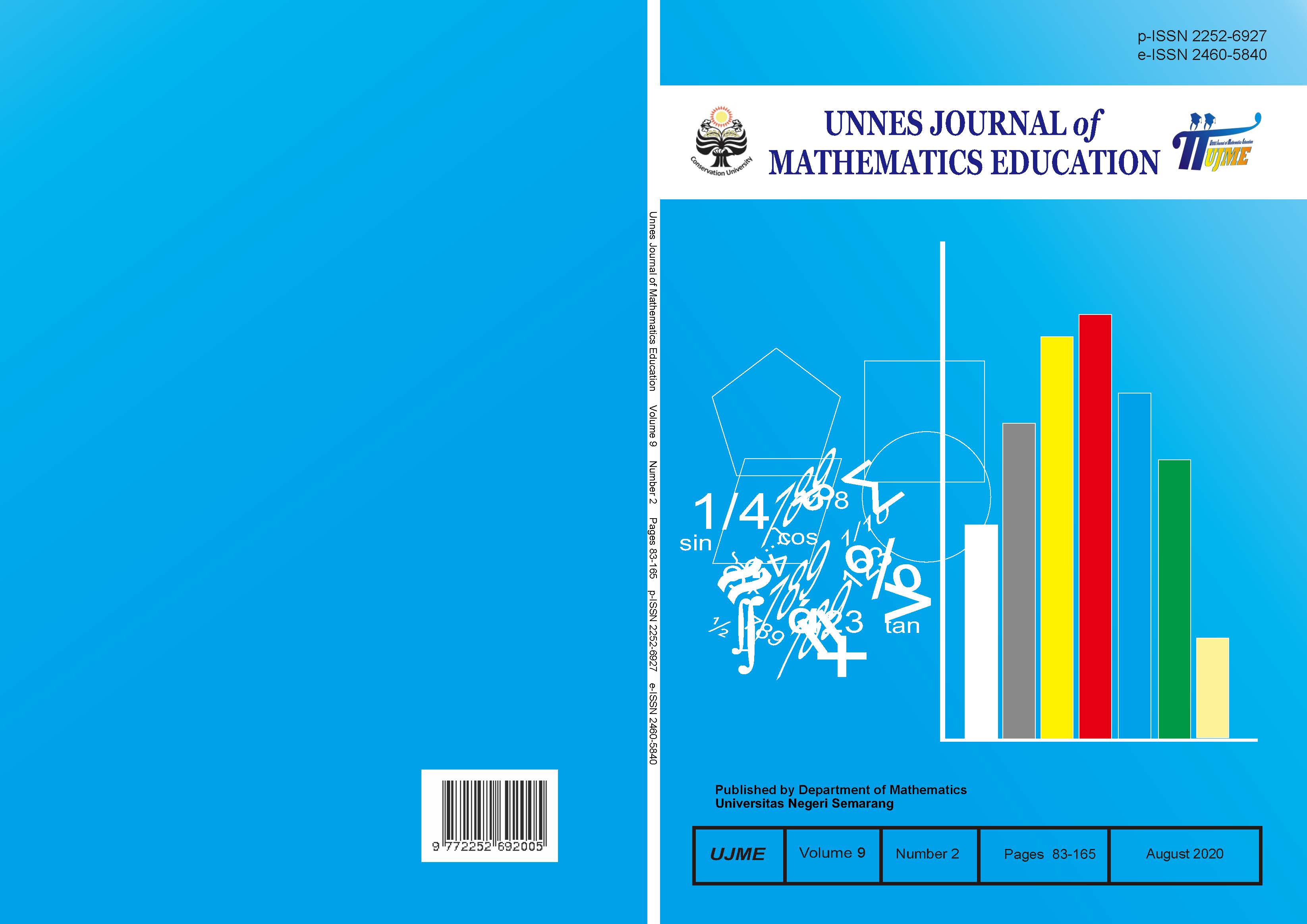Developing Problem Based Learning supplemental materials to increase 7th graders higher-order thinking skills
##plugins.themes.academic_pro.article.main##
Abstract
The study developed Problem Based Learning supplemental materials and aimed to (1) determine the characteristics of the supplemental materials, (2) determine the validity and readability of the supplemental materials, and (3) analyze the increase of Higher Order Thinking Skills after using the supplemental materials in the classroom. The method used in this research is research and development with 3D models (define, design, and develop). The increase of Higher Order Thinking Skills was analyzed by comparing the learning outcomes of the class that used the supplemental materials and class that used the default materials provided by schools. The population in this study were six classes of 7th grade of a Junior High School in Ungaran. The samples were selected by a random sampling technique to find a class for the experimental class and another class as a control class. Data were analyzed using a t-test and gain test. The study concluded that using Problem Based Learning supplemental material increased the Higher Order Thinking Skills of students.
##plugins.themes.academic_pro.article.details##
References
Anderson, L.W., & Krathwohl, D.R. (2001). A Taxonomy for Learning, Teaching, and Assesing; A revision of Bloom’s Taxonomy of Education Objectives. New York: Addison Wesley Lonman Inc.
Ayodele & Olagoke, M. (2012). Readability of Basic Science and Technology Textbooks for Primary Schools. Research Journal in Organizational Psychology and Educational Studies, 1(1): 33-36.
Hidayati, A. U. (2017). Melatih Keterampilan Berpikir Tingkat dalam Pembelajaran Matematika pada Siswa Sekolah Dasar (Training Thinking Skills in Mathematics Learning on Elementary Students). Terampil Jurnal Pendidikan Dan Pembelajaran Dasar, 4(20), 143–156.
Ibrahim, M. & Nur, M. (2002). Pengajaran Berdasarkan Masalah (Teaching Problem Based). Surabaya: Unesa University Press.
Learning and Teaching Support Network (LTSN). (2001). Problem-Based Learning:An Introduction. Primer 4, Version 1.
Lewy, Zulkardi, & Aisyah, N. (2009). Pengembangan Soal untuk Mengukur Kemampuan Berpikir Tingkat Tinggi Pokok Bahasan Barisan dan Deret Bilangan di Kelas IX Akselerasi SMP Xaverius Maria Palembang (Developing Assessment to Measure Higher Order Thinking Skills on Sequence and Series in 9th Grade Acceleration Students of Xaverius Maria Palembang JHS). JURNAL Pendidikan Matematika (3) : 15-28.
Murtiwi, W. (2015). Bahan Ajar Berbasis Masalah Untuk Meningkatkan Kompetensi Penyelesaian Masalah Matematis Siswa SMP (Teaching Materials Problem Based to Increase Problem Solving Competence). FKIP Universitas Tanjungpura, 1(2), 1–17.
Pariska, I. S., Elniati, S., & Syafriandi. (2012). Pengembangan Lembar Kerja Siswa Berbasis Masalah (Developing Problem Based Students Worksheets). Jurnal Pendidikan Matematika, 1(1), 75–80.
Pratini, H. S., & Widyaningsih, R. (2018). Keterampilan Berpikir Tingkat Tinggi Calon Guru Matematika Dan Upaya Untuk Menstimulasinya (Higher Order Thinking Skills Mathematics Teacher Candidates and Its Effort to Stimulate). Prosiding Seminar Nasional FKIP 2018, 1(1), 181–189.
Rahmadani, S., Harahap, F., & Hasruddin. (2016). Pengembangan Bahan Ajar Mikrobiologi Pangan Berbasis Masalah (Developing Food Microbiology Problem Based Teaching Materials). Jurnal Pendidikan Biologi, 5(3), 187–192.
Rajagukguk, W., & Simanjuntak, E. (2013). Pengembangan Bahan Ajar Matematika Berbasis Kemampuan Berpikir Kritis (Developing Critical Thinking Based Mathematics Teaching Materials) . Penelitian Bidang Pendidikan, 19(2), 105–111.
Saido, G. M., Siraj, S., Nordin, A. B. Bin, & Amedy, O. S. A. (2015). Higher Order Thinking Skills Among Secondary School Students in Science Learning. The Malaysian Online Journal of Educational Science, 3(3), 13–20.
Saragih, S., & Napitupulu, E. (2015). Developing Student-Centered Learning Model To Improve High Order Mathematical Thinking Ability. International Education Studies, 8(6).
Savinainen, A. (2004). High School Studets Conceptual Coherence of Qualitative Knowledge in the Case of the Force Concept. Disertation. University of Joensuu.
Sugiyono. (2010). Metode Penelitian Pendidikan : Pendekatan Kuantitatif, Kualitatif dan R & D (Education Research Methods: Quantitative, Qualitative and R&D Approaches). Bandung: Alfabeta.
Wicasari, B., & Ernaningsih, Z. (2016). Analisis Kemampuan Berpikir Siswa Dalam Menyelesaikan Permasalahan Matematika yang Berorientasi pada HOTS (Analysis of Thinking Ability of Students in Solving Mathematics HOTS Problem Oriented. Prosiding Seminar Nasional Reforming Pedagogy 2016, 1(1), 249-254.
Widodo, A.T. (1995). Modifikasi Teks Rumpang untuk Bahan Ajar MIPA (Modification of Hiatus Text for Mathematics an Natural Science Teaching Materials. Kampus Bendan Ngisor: Lembaga Penelitian IKIP Semarang.
Widodo, T., & Kadarwati, S. (2013). Higher Order Thinking Berbasis Pemecahan Masalah untuk Meningkatkan Hasil Belajar Berorientasi Pembentukan Karakter Siswa (Higher Order Thinking Skills Problem Solving Based to Increase Students Character Oriented Study Result. Jurnal Cakrawala Pendidikan, 5(1), 161–171.
